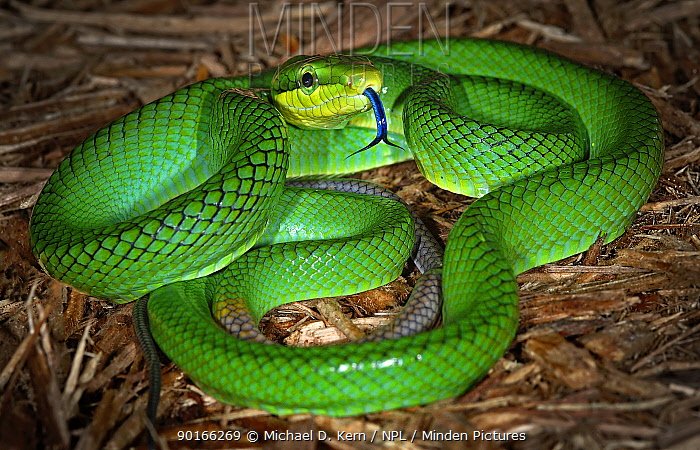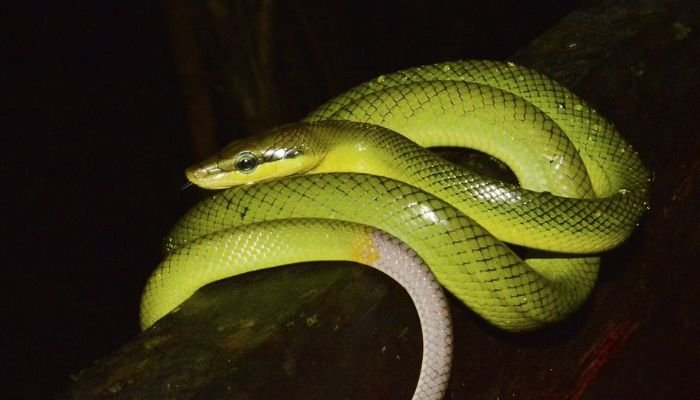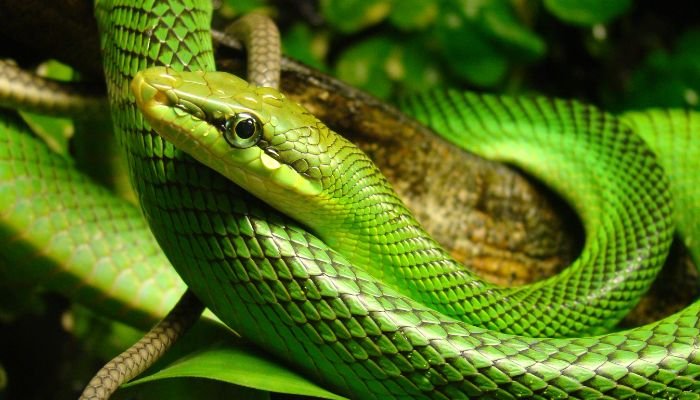
Southeast Asia is home to the beautiful, nonvenomous Red-Tailed Green Ratsnake. With its vibrant green coloring and distinctive red tail, the Red-Tailed Green Ratsnake is a visually striking reptile. It is primarily arboreal and feeds primarily on rodents and birds. The Red-Tailed Green Ratsnake faces conservation issues due to habitat loss and the illicit wildlife trade. The survival of this fascinating serpent species depends on safeguarding its natural habitats and putting an end to illegal activity.. Here are Red-tailed green ratsnake Guide on Food, Habitat, Size, Lifespan & Predators below-
Red-tailed green ratsnake Stats in Table format
The stats are given below for Red-tailed green ratsnake
| Reptiles List | Red-tailed green ratsnake |
|---|---|
| Family | Colubridae |
| Type | Snake |
| Size | Medium |
| Length | Red-tailed green ratsnake: Up to 4-6 feet (1.2-1.8 meters) |
| Color | Red-tailed green ratsnake: Usually has a green coloration with red or orange patterns or markings on the tail. |
| Weight | Red-tailed green ratsnake: Can weigh between 2 to 5 pounds.. |
| Lifespan | 10-15 years (or more) |
| Reproduction | Oviparous, lays eggs |
| Gestation Periods | The gestation period for a red-tailed green ratsnake is approximately 60-70 days. |
| Endangered Status | Least Concern (IUCN Red List) |
| Features | Bright green color, slender body |
| Country & Areas | Southeast Asia, including Thailand, Malaysia, Indonesia, and the Philippines. |
Red-tailed green ratsnake Natural Habitat and Distribution
Non-venomous colubrid snake found in Southeast Asia; scientific name, Gonyosoma oxycephalum (Red-tailed green ratsnake). Forests, woodlands, meadows, and agricultural areas are all part of its native habitat. These snakes have a wide range because of their adaptability; they can live successfully in both lowland areas and higher elevations.
The Red-tailed green ratsnake can be found in Southeast Asian nations such as Thailand, Malaysia, Indonesia, Cambodia, Myanmar, and the Philippines. Because they are such skilled climbers, they tend to congregate in places where there is a lot of vegetation to use as perches.
Red-tailed green ratsnake Physical Features and Adaptations
Here are some information about Red-tailed green ratsnake Physical Features and Adaptations:
1. Body Structure
The arboreal lifestyle of the red-tailed green ratsnake is reflected in its body shape, which is typically long and lean. Their prehensile tails are powerful and contribute to their remarkable climbing ability. These snakes can reach a length of 4 to 6 feet (1.2 to 1.8 meters) on average, with females often being larger than males.
2. Coloration and Patterns
The Red-tailed green ratsnake is able to blend in well with its native environment thanks to its emerald green dorsal colour. As the name suggests, their bright red tails might vary in intensity but are always noticeable. Black and white spots, or splotches, may also appear on the skin of some people.
3. Defense Mechanisms
To protect themselves, Red-tailed green ratsnakes may hiss, puff out to look bigger, and vibrate their tails if they feel attacked. They are not poisonous, but they will bite if they feel threatened. However, their ability to camouflage with their surroundings is their major defense against predators.

Red-tailed green ratsnake Diet and Feeding Habits
Here are some information about Red-tailed green ratsnake Diet and Feeding Habits
1. Diet Type
Carnivorous by nature, red-tailed green ratsnakes dine mostly on rodents, birds, and even lizards. The venom they use to immobilize prey is only mildly toxic to humans, yet this does not stop them from being classified as “venomous.”
2. Preferred Food Sources
These snakes are highly effective canopies due to their natural diet of rodents that live there. They are considered to be opportunistic eaters, taking advantage of any available source of food.
3. Feeding Schedule
Because their prey is most active at night, red-tailed green ratsnakes are mostly nocturnal hunters. They tend to hunt and eat once a week, though this can vary based on the size of their most recent meal and the accessibility of food.
Red-tailed green ratsnake Housing and Enclosure Requirements
Here are some information about Red-tailed green ratsnake Housing and Enclosure Requirements
1. Terrarium Size and Setup
A large, vertically-oriented terrarium is ideal for housing pet Red-tailed green ratsnakes. An adult snake needs a minimum enclosure size of 3 ft (0.9 m) in length, 2 ft (0.6 m) in width, and 4 ft (1.2 m) in height. Give them plenty of places to climb and rest in order to foster climbing and a sense of safety.
2. Substrate Options
Soil amendments like cypress mulch or coconut coir are great options since they keep soil wet for longer. These surfaces not only help keep humidity levels steady, but also simulate the snake’s native habitat.
3. Temperature and Lighting
Red-tailed green ratsnakes need a habitat with a temperature gradient. The ideal temperature range for the enclosure is 85-88 degrees Fahrenheit (29-31 degrees Celsius) on the warm side and 75-80 degrees Fahrenheit (24-27 degrees Celsius) on the cool side. To create this temperature difference, place heating pads or ceramic heat emitters under the tank. They would benefit medically from UVB lighting as well.
4. Humidity and Water Needs
As a tropical species, the ideal humidity for a Red-tailed green ratsnake is between 60% and 80%. Misting the enclosure on a regular basis can keep the humidity just right. Also, make sure the snake has plenty of water to drink and soak in.
Red-tailed green ratsnake Behaviour and Temperament
Here are some information about Red-tailed green ratsnake Behaviour and Temperament
1. Activity Levels
These snakes are nocturnal in the wild, but they may become more active during the day if raised in captivity. They are skilled climbers and frequently venture out at night to investigate their surroundings.
2. Social Behaviour
There is little evidence of social behavior in red-tailed green ratsnakes, which are primarily solitary. They have no problem with being left alone in their cage.
3. Handling and Taming
A Red-tailed green ratsnake can be socialized to humans by being handled often and gently beginning when it is still a juvenile animal. However, as with any snake, they require special care and attention to avoid putting them under unnecessary stress.
Red-tailed green ratsnake Breeding and Reproduction
Here are some information about Red-tailed green ratsnake Breeding and Reproduction
1. Mating and Courtship Rituals
The wet season is prime time for breeding since it provides ideal conditions for hatchling survival. In order to woo potential mates, male Red-tailed green ratsnakes will perform elaborate courtship displays, which include head-bobbing and body undulation.
2. Incubation and Hatchlings
Female Red-tailed green ratsnakes will nest in a secret location after mating is complete. Incubation of the eggs might take anything from a few days to a few weeks. After emerging from their eggs, the newborns are immediately on their own.
Red-tailed green ratsnake Common Health Issues and Veterinary Care
Here are some information about Red-tailed green ratsnake Common Health Issues and Veterinary Care
1. Respiratory Infections
Red-tailed green ratsnakes, like all reptiles, are vulnerable to respiratory illnesses if the humidity and temperature of their enclosure are not properly managed.
2. Parasites:
Parasites, both internal and external, can be a problem for snakes in captivity. Monitoring feces and administering preventative medicines on a regular basis can help control parasite populations.
3. Metabolic Bone Disease
Weakened bones and other health problems can occur from metabolic bone disease, which can be caused by a lack of calcium and vitamin D3 in the diet or inadequate exposure to UVB sun.

Importance of Regular Vet Check-ups
The health of pet Red-tailed green ratsnakes depends on regular visits to the vet. Veterinarians who specialize in reptiles may do in-depth checks, provide appropriate diets, and spot health problems in their earliest, most treatable stages. Prevention is the key to keeping these lovely snakes alive and well in captivity for as long as possible.
Conclusion
As a species, the red-tailed green ratsnake is remarkable for more reasons than one. Its extraordinary climbing powers and ability to adapt to new environments have helped it thrive across Southeast Asia. They need special attention as pets, such as a secure environment, nutritious food, and frequent veterinary checkups. Snakes are fascinating creatures, and those who take the time to learn about and care for them will have a lifelong appreciation for them.
FAQs
Q: What is the family and Type of an Red-tailed green ratsnake?
The Boa constrictor, a member of the boidae family, is a massive snake that poses little threat to humans.
Q: What is the average size of a Red-tailed green ratsnakes?
The average length of a Red-tailed green ratsnake is 0.9 to 1.2 meters (approximately 3 to 4 feet).
Q: How long can a Red-tailed green ratsnakes grow in size and length?
The length of an adult red-tailed green ratsnake is between 1.5 and 1.8 meters (5 and 5 feet).
Q: What colors do Red-tailed green ratsnakes come in?
Despite having green bodies, these snakes have earned the nickname “red-tailed green ratsnake” due to their brightly colored tails of red or orange.
Q: How big can a Red-tailed green ratsnakes get in weight?
The size of a red-tailed green ratsnake can vary between a pound and a pound and a half.
Q: How long do Red-tailed green ratsnakes live?
Red-tailed green ratsnakes can survive up to 15 years in captivity, but this is unlikely to be the case in the wild.
Q: How do Red-tailed green ratsnakes give birth?
Red-tailed green ratsnakes are oviparous, which means they lay eggs rather than giving birth to live offspring. The mother snake will take care of her eggs until they hatch after she lays them.
Q: How long is the gestation period for a Red-tailed green ratsnakes?
It takes about 50-60 days for a female red-tailed green ratsnake to give birth to her young.
Q: Is the Red-tailed green ratsnakes endangered?
Since my last update in September 2021, the Red-tailed green ratsnake’s status has not altered. While older sources may still contain some useful information, the IUCN Red List and more recent publications contain the most latest data on their conservation status.
Q: What are the prey of Red-tailed green ratsnakes?
The red-tailed green ratsnake’s food consists primarily on rodents, specifically mice and rats. Wrapping their bodies around their prey and squeezing until the victim loses consciousness is how constrictors kill them.
Q: Do Red-tailed green ratsnakes have any Predators?
The red-tailed green ratsnake may be preyed upon in the wild by birds of prey and other large mammals. Snakes are more vulnerable to predators when they are young, but as they grow older, that risk decreases.
Q: How Fast Does Red-tailed green ratsnakes Move?
Unfortunately, red-tailed green ratsnakes are not very fast. When hunting, they prefer to sneak up on their prey softly and quietly.
Q. What is Bite Force of Red-tailed green ratsnakes in PSI?
Red-tailed green ratsnakes are not known for having particularly powerful bites in compared to larger snake species. However, there are no data available on the biting force of this species in terms of PSI.
Q. Can we keep Red-tailed green ratsnakes as pets?
If you have experience caring for reptiles, then the answer is yes. They require careful attention and can be challenging to handle, therefore inexperienced hands should stay away from them. Before bringing one into your house as a pet, make sure you’re ready to take on the responsibilities and master the skills needed to properly care for one.
Q. Are Red-tailed green ratsnakes good for pest control?
Red-tailed green ratsnakes are a useful tool for pest control in areas where rodents are a problem, such as barns and storage sheds. They help with natural pest management because rodents make up the bulk of their diet.
Q. Do Red-tailed green ratsnakes require a UVB light source?
I hope you like reading on Red-tailed green ratsnake FAQ Guide on Food, Habitat, Size, Lifespan and Predators.
